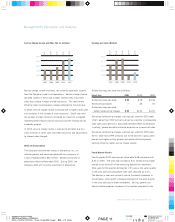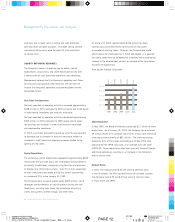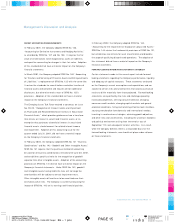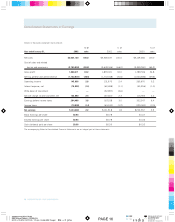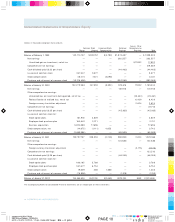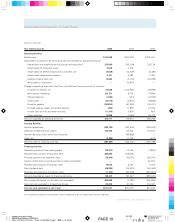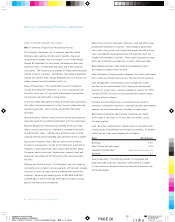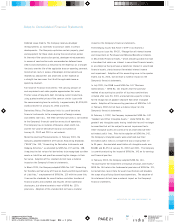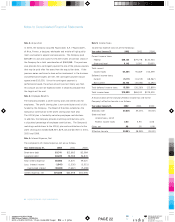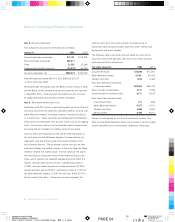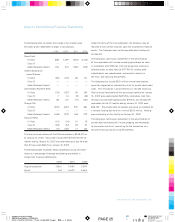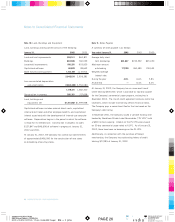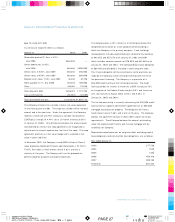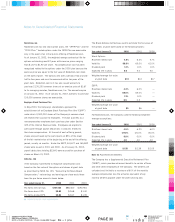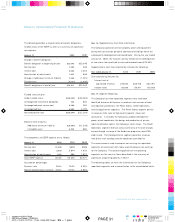Nordstrom 2001 Annual Report Download - page 23
Download and view the complete annual report
Please find page 23 of the 2001 Nordstrom annual report below. You can navigate through the pages in the report by either clicking on the pages listed below, or by using the keyword search tool below to find specific information within the annual report.
Blk + 1 pms PAGE 21 pms
550
Cyan Mag Yelo Blk
20200324 NORDSTROM
2001 Annual Report • VERSION
8.375 x 10.875 • SCITEX • 175 lpi • Kodak 80# Cougar
Notes to Consolidated Financial Statements
NORDSTROM INC. AND SUBSIDIARIES 21
Deferred Lease Credits: The Company receives developer
reimbursements as incentives to construct stores in certain
developments. The Company capitalizes certain property, plant
and equipment for these stores during the construction period.
At the end of the construction period, developer reimbursements
in excess of construction costs are recorded as deferred lease
credits and amortized as a reduction to rent expense, on a straight-
line basis over the life of the applicable lease or operating covenant.
Construction costs in excess of developer reimbursements are
recorded as prepaid rent and amortized as rent expense on
a straight-line basis over the life of the applicable lease or
operating covenant.
Fair Value of Financial Instruments: The carrying amount of
cash equivalents and notes payable approximates fair value.
The fair value of long-term debt (including current maturities),
using quoted market prices of the same or similar issues with
the same remaining term to maturity, is approximately $1,378,000
and $1,041,000 at January 31, 2002 and 2001.
Derivatives Policy: The Company limits its use of derivative
financial instruments to the management of foreign currency
and interest rate risks. The effect of these activities is not material
to the Company’s financial condition or results of operations.
The Company has no material off-balance sheet credit risk,
and the fair value of derivative financial instruments at
January 31, 2002 and 2001 is not material.
Recent Accounting Pronouncements: In February 2001, the
Company adopted Statement of Financial Accounting Standards
(“SFAS”) No. 133, “Accounting for Derivative Instruments and
Hedging Activities,” as amended by SFAS No. 137 and No. 138.
It requires the fair value of all derivatives to be recognized as either
assets or liabilities and specifies accounting for changes in their
fair value. Adoption of this standard did not have a material
impact on the Company’s financial statements.
In March 2001, the Company adopted SFAS No. 140 “Accounting
for Transfers and Servicing of Financial Assets and Extinguishments
of Liabilities,” a replacement of SFAS No. 125 with the same title.
It revises the standards for securitizations and other transfers of
financial assets and collateral and requires certain additional
disclosures, but otherwise retains most of SFAS No. 125’s
provisions. Adoption of this standard did not have a material
impact on the Company’s financial statements.
The Emerging Issues Task Force (“EITF”) has reached a
consensus on Issue No. 99-20, “Recognition of Interest Income
and Impairment on Purchased and Retained Beneficial Interests
in Securitized Financial Assets,” which provides guidance on how
a transferor that retains an interest in securitized financial assets,
or an enterprise that purchases a beneficial interest in securitized
financial assets, should account for related interest income
and impairment. Adoption of this accounting issue in the quarter
ended July 31, 2001, did not have a material impact on the
Company’s financial statements.
In July 2001, the FASB issued SFAS No. 141 “Business
Combinations.” SFAS No. 141 requires that the purchase
method of accounting be used for all business combinations
initiated after June 30, 2001, and establishes specific criteria
for the recognition of goodwill separate from other intangible
assets. Adoption of the accounting provisions of SFAS No. 141
in February 2002 did not have a material impact on the
Company’s financial statements.
At February 1, 2002, the Company implemented SFAS No. 142
“Goodwill and Other Intangible Assets.” Under SFAS No. 142,
goodwill and intangible assets having indefinite lives will no longer
be amortized but will be subject to annual impairment tests.
Other intangible assets will continue to be amortized over their
estimated useful lives. Prior to the adoption of SFAS No. 142,
the Company’s intangible assets were amortized over their
estimated useful lives on a straight-line basis ranging from 10
to 35 years. Accumulated amortization of intangible assets was
$5,881 and $1,251 at January 31, 2002 and 2001. The Company
is currently evaluating the impact of SFAS No. 142 on its earnings
and financial position.
In February 2002, the Company adopted SFAS No. 144,
“Accounting for the Impairment or Disposal of Long-Lived Assets.”
SFAS No. 144 retains the fundamental provisions of SFAS No. 121,
but establishes new criteria for asset classification and broadens
the scope of qualifying discontinued operations. The adoption of
this statement did not have a material impact on the Company’s
financial statements.


